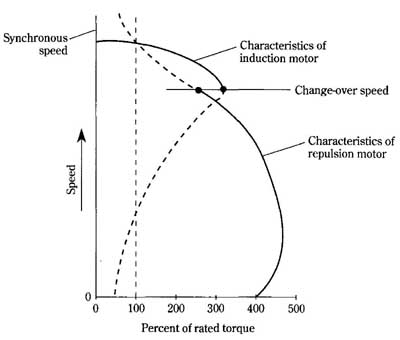AMAZON multi-meters discounts AMAZON oscilloscope discounts
. The important characteristics of the repulsion motor and the induction motor are essentially complementary—the repulsion motor has a very high starting torque but poor speed regulation in the normal operating range, whereas the basic single-phase induction motor develops no starting torque but is a near-constant speed machine once it’s operating with normal loads. Therefore, hybrid machines utilizing both motor principles have evolved.
It so happens that, if the commutator segments of a repulsion motor are short-circuited, the previously commutated armature winding simulates quite closely the squirrel-cage rotor of an induction motor. This being the case, a repulsion motor de signed with a centrifugally actuated shorting mechanism can start as a repulsion motor and, at about 80 percent of synchronous speed, can shift to the operating mode of an induction motor. This is the appropriately named repulsion-start induction motor. The basic idea is illustrated in FIG. 15. Pivoted copper segments, represented by the radial arrows, are kept parallel to the shaft by a spring when the motor is at standstill or is rotating below 80 percent of synchronous speed. As the motor accelerates, centrifugal force ultimately overcomes the force exerted by the spring and the pivoted segments move outward to make physical contact with the inner surface of the commutator. The machine then operates as an induction motor.

FIG. 15 The repulsion-start induction motor.
The characteristics of the repulsion-start induction motor are shown in FIG. 16. Notice that the transition between the two modes of operation takes place at the speed where the induction-motor torque exceeds that of the motor operating in the repulsion mode. Often, the centrifugal mechanism also lifts the brushes from contact with the commutator at the same time that the short-circuiting action occurs. Tins action extends the life of both the commutator and the brushes.

FIG. 16 Characteristics of the repulsion-start induction motor. Characteristics
of induction motor; Change-over speed
Reversal of rotation is accomplished by shifting the brush axis. Some designs in corporate separate field windings in order to facilitate reversal. The repulsion-start induction motor is made in both fractional- and integral-horsepower sizes. It’s a capable workhorse where polyphase power is not available, but it tends to be noisy, expensive, and it requires relatively high maintenance. An additional negative factor in some applications is the high level of RFI generated during the starting interval. This can play havoc with communications and video equipment, and requires due consideration whenever digital-logic circuits are situated nearby.
---- --